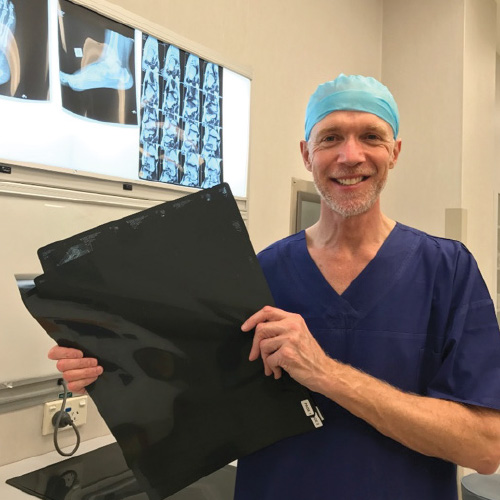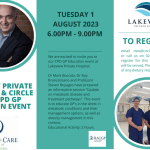Test? What test? Imaging of the Injured Foot and Ankle made simple
Dr A. Scott Newman
MBBS FRACS(Ortho) FAOA
02 8711 0100
Lakeview Private Hospital Orthopaedics
Suite 1, Level 1
17-19 Solent Circuit
Bella Vista NSW 2153
Exposed to an ever-more-sophisticated arsenal of readily-available diagnostic tools, it’s tempting for the acute care doctor to reach for his referral pad and pass diagnostic decision-making responsibilities over to his friendly radiologist! But is it always necessary to do a “test” and is the best test always the most sophisticated one?
Let’s look first at a common and sentinel example. Here we fall back on the basic tenets of history and examination and I cannot emphasise too strongly the importance of that most-basic of diagnostic “instruments”: the “examining eye on the end of the finger”. Typically, this diagnosis makes itself, when the patient walks through the door and tells you of the snapping sensation experienced whilst participating in an unaccustomed high impact activity. It’s a tendo achilles rupture, nothing less, until proven otherwise. Diagnostic “game, set and match” is visualising and palpating a tendon defect, accompanied by a loss of normal ankle posture and tone, and a positive Thompson’s test. An ultrasound is never needed, and can indeed be frankly misleading. If it’s a late presentation, when the cardinal signs of rupture become more ill-defined, nothing short of an MRI will do!
On the suspicion of a fractured ankle or foot, appropriate x-ray views are mandatory and an ultasound should never be considered. If plain radiographs don’t reveal the diagnosis, or adequately display it, a fine-slice CT is the next step. MRI is not helpful in this setting.
The patient who presents with a twisting ankle or hindfoot injury will assist you in shortening the differential diagnosis list with a description of where the pain and swelling started. The simple and accurate Drawer Test for a ruptured ATFL could save the health budget millions of dollars annually if it were routinely performed in this setting, as it dispenses with the need for the notoriously inaccurate and unreliable ultrasound! Whilst an x-ray is still necessary in most cases to help rule out a fracture, the history and clinical examination will already have determined that this patient belongs in a CAM Boot. MRI is the investigation of choice later and only if and when symptoms fail to spontaneously resolve, raising the spectre of occult pathology.
Pain and swelling developing atraumatically after unaccustomed or overactivity may well be a stress reaction or fracture, and will only be seen on x-rays of cortical bone after two or three weeks. Otherwise, order a Bone Scan or MRI……… never, you guessed it, an ultrasound!
A twisting, loaded injury when a patient reports pain and swelling about the midfoot should always be x-rayed, but with an eye for subtle avulsive fracture fragments or subluxation, and with projections parallel to the suspicious joints. Weight-bearing views may better reveal the subluxation, and a CT is ideal to map the anatomical detail of this injury, whilst nothing short of an MRI will actually show the infamous Lisfranc ligament whose rupture is so often missed!
When requesting CT and MRI imaging, seek out high resolution options and always ask for a study targeted at the area of concern. There’s no utility in scanning an entire foot when the pathology is clearly in the great toe!






